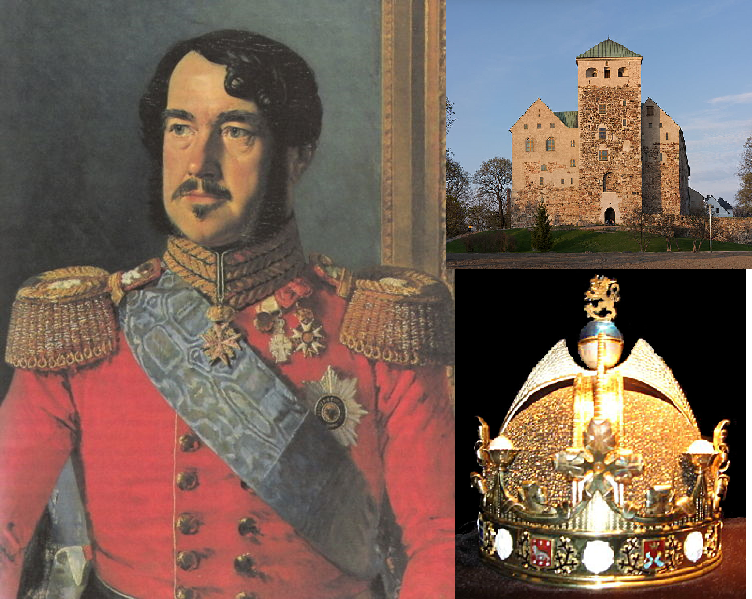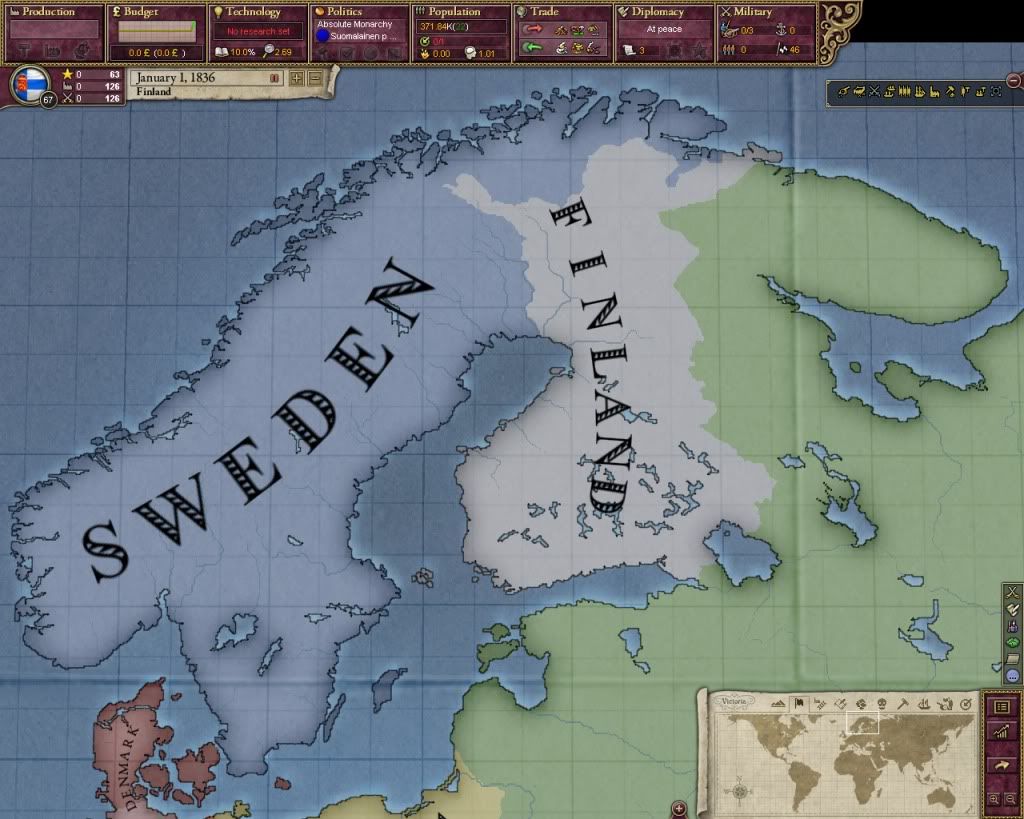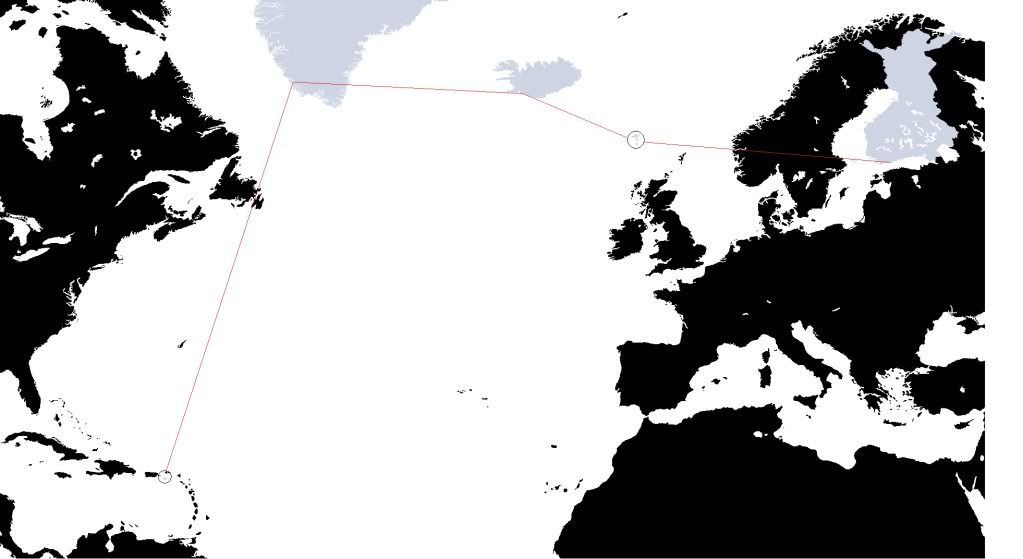This is my first AAR, so any feedback and constructive criticism are more than welcome.
Prologue - Events leading to the finnish independence
Diet of Porvoo

The man dipped the head of his quill in a bottle of ink, took a final look of the document presented to him, and signed his name with clear, steady letters.
Alexander I
He handed the document to the head of the finnish delegation, C. E. Mannerheim, who accepted it, and bowed to the tsar. The independent Finland was born.
The reign of Konstantin I
The independence of Finland was little more than a lucky coincident. Russia and Sweden had been fighting on the finnish lands for centuries, and finally, in the Finnish War of 1808 and 1809 Russia managed to take the entire region from Sweden.
Instead of integrating Finland to the vast Russian Empire, Tsar ALexander I, known for his liberal views, decided to turn it into a buffer state between Russia and Sweden. Because althought Sweden had been steadily weakened over the past century, and was far from its days of glory, its close proximity to the russian capital of St. Petersburg formed a considerable threat. Even economically, apart from few iron deposits in Eastern Finland, the land was barren and poor.
Althought completelly sovereign on paper, Finland remained under a great russian influence. Alexander's brother, Constantine Pavlovich was crowned the king of the newlyborn nation under the name Constantine I, whose position Alexander supported strongly both politically and militarily until his death.

Constantine I, the first king of Finland.
As a ruler, Constantine was extremely unpopular from the beginning. The king hated his backward and poor realm, and practically never even visited there, spending most of his time at St. Petersburg. He was also a cruel and incompetent leader, causing nationwide famine with his heavy taxation policies. Only thing that kept finns from revolting was the presence of the imperial army.
The Civil War
After Alexander's death under shady circumstances in 1825, his brother Nicholas assumed the russian throne. As one of his first acts as the tsar, he pulled russian troops out of Finland. He felt that keeping peace in some petty backwater at a rather large expence was completely pointless.

Tsar Nicholas I
Only three months after the imperial army had left the country, the Diet of Finland was assembled at Turku, and it was unanimously decided that Constantine I could not continue his reign as the king of Finland. The official reason for this was, that Constantine did not spend enough time in finland, and thus wasn't qualified to rule. The king himself took this quite calmly. When the news reached him at St. Petersburg, he simply responded that "The estonians will just have to do without me."
For Finland, however, this marked the beginning of difficult times. Althought the diet was unanimous about the overthrowing of Constantine, they could not come to conclusion about the form of government of Finland. The conservative Kuninkaalliset(Royalists) wanted to keep the old monarchy, and simply replace the king, and the reformist Jakobiinit(Jacobins) wanted to follow in the footsteps of the French revolution, and turn Finland into a republic.
The relations of the two parties got tenser and tenser, until on 4 February 1826, after the battle of Hämeenlinna, the situation escalated into a full-scale civil war. Kuninkaalliset declared Finland a monarchy, with its capital in Turku, while Jakobiinit formed a republic in Helsinki.
Väinö I
The bloody civil war ravaged the country for years, with neither side gaining the decisive victory over another, until in 1835 Kuninkaalliset, led by C. E. Mannerheim, finally managed to persuade William, a landgrave of Hesse-Kassel, to become their new king.
In the July of the same year, the armies of the Electorate of Hesse-Kassel landed outside Inkoo in Southern Finland to secure the position of the new king. Well organized hessian mercenaries soon occupied Helsinki, and on 27 September the last of Jakobiinit surrendered. William was crowned on Christmas Eve of the same year under the name Väinö I, after an ancient finnish folk hero Väinämöinen. Helsinki was made the administrative capital, because the old capital Turku was thought to be too swedish, althought the Turku Castle was made the primary residence of the monarch. A government was hastily formed from the leaders of Kuninkaalliset, with C. E. Mannerheim as the prime minister. Finally, after a long and rocky road, Finland was truly and completely independent.

King Väinö I, his crown and the Turku Castle

Carl Erik Mannerheim, prime minister of Finland
I will try to update on the actual gameplay as soon as possible.
Prologue - Events leading to the finnish independence
Diet of Porvoo

The man dipped the head of his quill in a bottle of ink, took a final look of the document presented to him, and signed his name with clear, steady letters.
Alexander I
He handed the document to the head of the finnish delegation, C. E. Mannerheim, who accepted it, and bowed to the tsar. The independent Finland was born.
The reign of Konstantin I
The independence of Finland was little more than a lucky coincident. Russia and Sweden had been fighting on the finnish lands for centuries, and finally, in the Finnish War of 1808 and 1809 Russia managed to take the entire region from Sweden.
Instead of integrating Finland to the vast Russian Empire, Tsar ALexander I, known for his liberal views, decided to turn it into a buffer state between Russia and Sweden. Because althought Sweden had been steadily weakened over the past century, and was far from its days of glory, its close proximity to the russian capital of St. Petersburg formed a considerable threat. Even economically, apart from few iron deposits in Eastern Finland, the land was barren and poor.
Althought completelly sovereign on paper, Finland remained under a great russian influence. Alexander's brother, Constantine Pavlovich was crowned the king of the newlyborn nation under the name Constantine I, whose position Alexander supported strongly both politically and militarily until his death.

Constantine I, the first king of Finland.
As a ruler, Constantine was extremely unpopular from the beginning. The king hated his backward and poor realm, and practically never even visited there, spending most of his time at St. Petersburg. He was also a cruel and incompetent leader, causing nationwide famine with his heavy taxation policies. Only thing that kept finns from revolting was the presence of the imperial army.
The Civil War
After Alexander's death under shady circumstances in 1825, his brother Nicholas assumed the russian throne. As one of his first acts as the tsar, he pulled russian troops out of Finland. He felt that keeping peace in some petty backwater at a rather large expence was completely pointless.

Tsar Nicholas I
Only three months after the imperial army had left the country, the Diet of Finland was assembled at Turku, and it was unanimously decided that Constantine I could not continue his reign as the king of Finland. The official reason for this was, that Constantine did not spend enough time in finland, and thus wasn't qualified to rule. The king himself took this quite calmly. When the news reached him at St. Petersburg, he simply responded that "The estonians will just have to do without me."
For Finland, however, this marked the beginning of difficult times. Althought the diet was unanimous about the overthrowing of Constantine, they could not come to conclusion about the form of government of Finland. The conservative Kuninkaalliset(Royalists) wanted to keep the old monarchy, and simply replace the king, and the reformist Jakobiinit(Jacobins) wanted to follow in the footsteps of the French revolution, and turn Finland into a republic.
The relations of the two parties got tenser and tenser, until on 4 February 1826, after the battle of Hämeenlinna, the situation escalated into a full-scale civil war. Kuninkaalliset declared Finland a monarchy, with its capital in Turku, while Jakobiinit formed a republic in Helsinki.
Väinö I
The bloody civil war ravaged the country for years, with neither side gaining the decisive victory over another, until in 1835 Kuninkaalliset, led by C. E. Mannerheim, finally managed to persuade William, a landgrave of Hesse-Kassel, to become their new king.
In the July of the same year, the armies of the Electorate of Hesse-Kassel landed outside Inkoo in Southern Finland to secure the position of the new king. Well organized hessian mercenaries soon occupied Helsinki, and on 27 September the last of Jakobiinit surrendered. William was crowned on Christmas Eve of the same year under the name Väinö I, after an ancient finnish folk hero Väinämöinen. Helsinki was made the administrative capital, because the old capital Turku was thought to be too swedish, althought the Turku Castle was made the primary residence of the monarch. A government was hastily formed from the leaders of Kuninkaalliset, with C. E. Mannerheim as the prime minister. Finally, after a long and rocky road, Finland was truly and completely independent.

King Väinö I, his crown and the Turku Castle

Carl Erik Mannerheim, prime minister of Finland
I will try to update on the actual gameplay as soon as possible.








